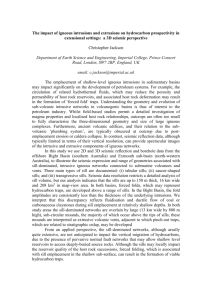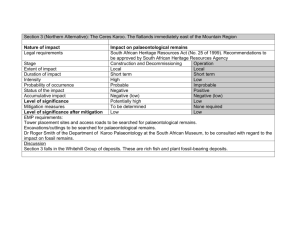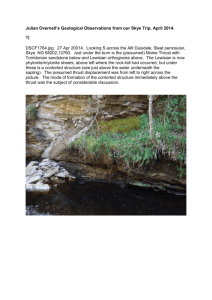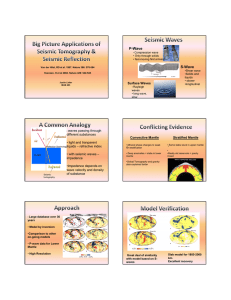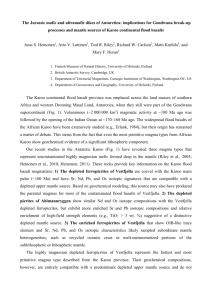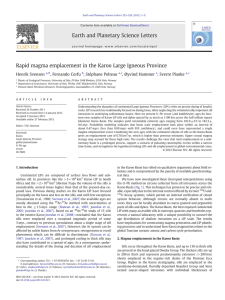Earth and Planetary Science
advertisement
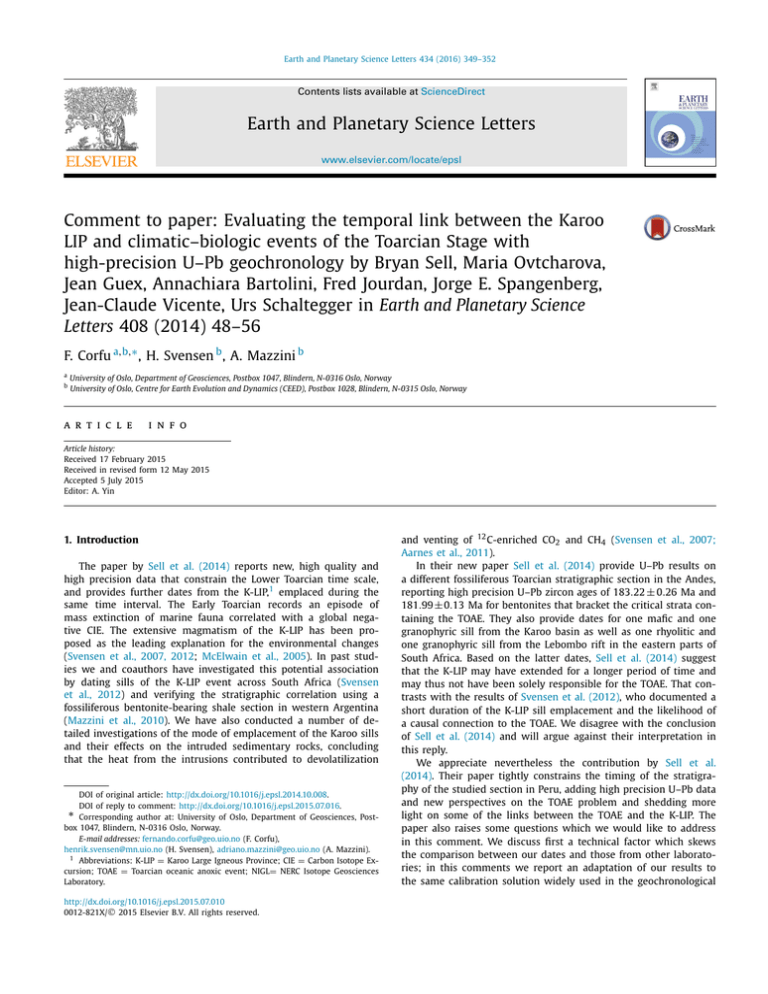
Earth and Planetary Science Letters 434 (2016) 349–352 Contents lists available at ScienceDirect Earth and Planetary Science Letters www.elsevier.com/locate/epsl Comment to paper: Evaluating the temporal link between the Karoo LIP and climatic–biologic events of the Toarcian Stage with high-precision U–Pb geochronology by Bryan Sell, Maria Ovtcharova, Jean Guex, Annachiara Bartolini, Fred Jourdan, Jorge E. Spangenberg, Jean-Claude Vicente, Urs Schaltegger in Earth and Planetary Science Letters 408 (2014) 48–56 F. Corfu a,b,∗ , H. Svensen b , A. Mazzini b a b University of Oslo, Department of Geosciences, Postbox 1047, Blindern, N-0316 Oslo, Norway University of Oslo, Centre for Earth Evolution and Dynamics (CEED), Postbox 1028, Blindern, N-0315 Oslo, Norway a r t i c l e i n f o Article history: Received 17 February 2015 Received in revised form 12 May 2015 Accepted 5 July 2015 Editor: A. Yin 1. Introduction The paper by Sell et al. (2014) reports new, high quality and high precision data that constrain the Lower Toarcian time scale, and provides further dates from the K-LIP,1 emplaced during the same time interval. The Early Toarcian records an episode of mass extinction of marine fauna correlated with a global negative CIE. The extensive magmatism of the K-LIP has been proposed as the leading explanation for the environmental changes (Svensen et al., 2007, 2012; McElwain et al., 2005). In past studies we and coauthors have investigated this potential association by dating sills of the K-LIP event across South Africa (Svensen et al., 2012) and verifying the stratigraphic correlation using a fossiliferous bentonite-bearing shale section in western Argentina (Mazzini et al., 2010). We have also conducted a number of detailed investigations of the mode of emplacement of the Karoo sills and their effects on the intruded sedimentary rocks, concluding that the heat from the intrusions contributed to devolatilization DOI of original article: http://dx.doi.org/10.1016/j.epsl.2014.10.008. DOI of reply to comment: http://dx.doi.org/10.1016/j.epsl.2015.07.016. Corresponding author at: University of Oslo, Department of Geosciences, Postbox 1047, Blindern, N-0316 Oslo, Norway. E-mail addresses: fernando.corfu@geo.uio.no (F. Corfu), henrik.svensen@mn.uio.no (H. Svensen), adriano.mazzini@geo.uio.no (A. Mazzini). 1 Abbreviations: K-LIP = Karoo Large Igneous Province; CIE = Carbon Isotope Excursion; TOAE = Toarcian oceanic anoxic event; NIGL= NERC Isotope Geosciences Laboratory. * http://dx.doi.org/10.1016/j.epsl.2015.07.010 0012-821X/© 2015 Elsevier B.V. All rights reserved. and venting of 12 C-enriched CO2 and CH4 (Svensen et al., 2007; Aarnes et al., 2011). In their new paper Sell et al. (2014) provide U–Pb results on a different fossiliferous Toarcian stratigraphic section in the Andes, reporting high precision U–Pb zircon ages of 183.22 ± 0.26 Ma and 181.99 ± 0.13 Ma for bentonites that bracket the critical strata containing the TOAE. They also provide dates for one mafic and one granophyric sill from the Karoo basin as well as one rhyolitic and one granophyric sill from the Lebombo rift in the eastern parts of South Africa. Based on the latter dates, Sell et al. (2014) suggest that the K-LIP may have extended for a longer period of time and may thus not have been solely responsible for the TOAE. That contrasts with the results of Svensen et al. (2012), who documented a short duration of the K-LIP sill emplacement and the likelihood of a causal connection to the TOAE. We disagree with the conclusion of Sell et al. (2014) and will argue against their interpretation in this reply. We appreciate nevertheless the contribution by Sell et al. (2014). Their paper tightly constrains the timing of the stratigraphy of the studied section in Peru, adding high precision U–Pb data and new perspectives on the TOAE problem and shedding more light on some of the links between the TOAE and the K-LIP. The paper also raises some questions which we would like to address in this comment. We discuss first a technical factor which skews the comparison between our dates and those from other laboratories; in this comments we report an adaptation of our results to the same calibration solution widely used in the geochronological 350 F. Corfu et al. / Earth and Planetary Science Letters 434 (2016) 349–352 community. We also use the opportunity to discuss some of the natural factors that can complicate the interpretation of high precision U–Pb data, with implications for the conclusions by Sell et al. (2014). Finally, we argue why the samples collected by Sell et al. (2014) cannot be used to draw conclusions about the duration of the sill emplacement in the Karoo Basin. 2. Bias in the published U–Pb results from Oslo The U–Pb data reported in Mazzini et al. (2010) and Svensen et al. (2012) were obtained with our own mixed 202 Pb–205 Pb–235 U spike, which has been calibrated against various reference solutions and having a U/Pb ratio considered to be known to better than 0.2%. More recent repeated measurements, using the same spike, of an artificial U–Pb solution (ET100) provided by the EARTHTIME initiative (Condon et al., 2007) reveal a small but reproducible difference, yielding an average value of 206 Pb/238 U = 0.0156513 versus the value of 0.015623 obtained with the ET2535 spike at NIGL (Condon, personal comm., 2014). The data published by Sell et al. (2014) were obtained using the same spike as NIGL. Such a bias has negligible effects on the data of most projects handled in the Oslo laboratory, but it becomes a more significant factor in projects involving time-scale dating or the resolution of short-lived magmatic and volcanic processes requiring the comparison of data sets from different sources. It is not evident whether the bias can be linked to the original calibration or whether the spike composition might slowly change with time, due for example to absorption in walls of the storage FEP bottle. The data in Mazzini et al. (2010) and Svensen et al. (2012) were obtained recently enough that this consideration is less relevant. They can therefore be adapted to match those obtained with the ET spike, for this Jurassic age involving a correction of +0.35 Ma. 3. Comparison The corrected ages are listed in Table 1 and plotted in Fig. 1. The two estimates of the timing of the CIE, from Sell et al. (2014) based on the Peru section and Mazzini et al. (2010) from the Argentinian section, overlap within uncertainty, although the latter extends to a younger time period. Conversely, Mazzini et al. (2010) extrapolate an age of 182.5 ± 0.6 Ma for the boundary between Pliensbachian and Toarcian, whereas Sell et al. (2014) suggest that Fig. 1. Compilation and comparison of results from Encarnacion et al. (1996), Sell et al. (2014) and Burgess et al. (2015) and the corrected ages of Svensen et al. (2007, 2012) and Mazzini et al. (2010). The extrapolated age of 182.5 ± 0.6 Ma for the Pliensbachian–Toarcian boundary proposed by Mazzini et al. (2010) may be too young depending on the stratigraphic interpretation. Further work on the details of the biostratigraphy is in progress. CIE = Carbon Isotopic Excursion; badd = baddeleyite. the boundary must be older than 183.5 Ma. Neither of the two studies could find datable volcanic horizons near the top of the Pliensbachian and the extrapolation relies on a proper estimate of the sedimentation rates in the strata below the lowest dated volcanic tuff. The bottom of the section investigated in Mazzini et al. (2010) has limited biostratigraphic constrains and thus the extrapolated age of the boundary is subjected to some uncertainty. More pronounced differences are evident with respect to the timing of the rocks associated with the K-LIP. Svensen et al. (2007, 2012) reported data for 15 mafic sills and dykes collected on a traverse across South Africa (Figs. 1–2). The ages obtained range from 182.7 to 183.4 Ma (Table 1), but essentially all overlap within error and were modelled to represent emplacement over a period of less than 0.47 myr. By contrast, Sell et al. (2014) dated two sills from the Karoo Basin (one giving a reliable age of 183.014 ± 0.072 Ma) Table 1 Ages of Karoo sills and dykes, from Svensen et al. (2007, 2012), and Argentinian tuffs from Mazzini et al. (2010), adapted to ET spike; 2σ − int = analytical uncertainty; 2σ + tr = analytical + tracer uncertainty; 2σ + tr + λ = analytical + tracer + decay constant uncertainty. No. Sample Karoo (Fig. 2) 1 2 3 4 5 6 7 8 9 10 11 12 13 14 UZ1 SP-07-05 SP-06-05 K08-13 K08-16 K08-34 K08-1 K08-6 SP08-05 K08-47 K08-48 K08-41 K08-31 QU1-2 K08-9 G39974 AS29 AS16. Age (Ma) 2σ − int 2σ + tr 2σ + tr + λ Dyke Dyke Sill Sill Sill Sill Sill Sill Sill Sill Sill Sill Sill Sill Sill 183.0 182.9 183.2 182.7 183.3 183.4 182.9 183.4 182.8 183.3 182.9 183.1 183.1 183.2 182.9 0.3 0.3 0.4 0.6 0.5 0.5 0.3 0.3 0.7 0.3 0.5 0.9 0.3 0.4 0.4 0.4 0.4 0.5 0.6 0.5 0.5 0.3 0.4 0.8 0.4 0.5 0.9 0.4 0.5 0.4 0.5 0.5 0.6 0.7 0.6 0.6 0.4 0.5 0.8 0.5 0.6 1.0 0.5 0.6 0.5 tuff tuff 180.9 181.8 0.4 0.2 0.5 0.3 0.6 0.4 Neuquen F. Corfu et al. / Earth and Planetary Science Letters 434 (2016) 349–352 351 Fig. 2. Geological map of the Karoo Basin showing sampling sites, numbered as in Fig. 1 and Table 1 (adapted from Svensen et al., 2012). together with two sills from the Lebombo rift giving ages of 181.31 ± 0.19 and 179.32 ± 0.18 Ma (Fig. 1). Thus, in summary, Sell et al. (2014) only present one new reliable age from the sill complex in the Karoo Basin. The two Karoo sills represent the main K-LIP sill complex crossed by the traverse sampled in our study (Fig. 2; Svensen et al., 2012). The granophyre studied by Sell et al. (2014) yields their oldest age of 183.014 Ma, which is well within the range of our dates. The other sample from the Karoo Basin only yielded baddeleyite, which show a range of ages for different grains. The results are deemed inconclusive by the authors, who suggest that the age range may represent protracted crystallization of baddeleyite in the magma chamber, although they also discuss a potential effect of Pb loss. A protracted crystallization of zircon in large silicic or bimodal magma systems is well documented, but whether the same applies for baddeleyite is more speculative. Baddeleyite is only stable in silica undersaturated systems, and it is a question whether one can maintain basaltic magma in the crust for extended periods of time without inducing extensive crustal melting and contamination, the consequent silicification of the magma destroying the stability field of baddeleyite and producing zircon. In general the mafic sill complexes have the character of relatively fast crystallized systems with little crustal contamination, evidenced also by the rarity of zircon xenocrysts in such rocks. The potential of having partially reset U–Pb ages of zircon and baddeleyite because of loss of Pb is also an important consideration. The authors have treated the zircon grains with chemical abrasion (Mattinson, 2005), which we agree is a very efficient way to eliminate zircon domains affected by Pb loss. However, the zircon populations in differentiated mafic sills can be extremely rich in U and zoned, and in some cases it is virtually impossible to eliminate all secondary Pb loss, unless one dissolves away all the grain. Based on our experience (e.g. Corfu et al., 2013) we would argue that it is next to impossible to avoid partially reset baddeleyite ages, unless the grains are large enough to minimize the effect of Pb loss from near-surface layers, surficial crystallization to zircon, and ideally are large enough so they can be air-abraded. Nucleous recoil during alpha decay leads automatically to some loss of daughter nuclides in the outer region of grains, and this effect can cause pronounced effects in very thin and small baddeleyite blades (Davis and Davis, 2010). The fact that the oldest age of 182.8 Ma in sample SA91 of Sell et al. (2014) was obtained from what seems to have been the largest baddeleyite grain analyzed (judging from the amount of Pb recovered) would support the suggestion that this rock is at least that old, again in agreement with our data. The second sample of that area, SA97, contains both zircon and baddeleyite, which show remarkably matched ages of 183.014 Ma for zircon and 183.07 Ma for baddeleyite. Some baddeleyite grains, however, yield older ages (up to 183.3 Ma). We accept Sell et al. (2014)’s interpretation, but nevertheless cannot avoid speculating whether Pb loss rather than protracted crystallization was the mechanism that caused the spread in baddeleyite ages, and hence a somewhat older age is likely. In any case, the data in these two samples from the southern domain of the Karoo Basin sill complex are perfectly in agreement with our (adapted) results indicating a relatively short-lived but areally extensive period of mafic sill emplacement across the Karoo Basin. The data are also consistent with the previous age of Encarnacion et al. (1996) from a nearby intrusion (Figs. 1–2). 4. The Lebombo volcanics and concluding remarks The two samples with the deviating younger ages of 181.31 ± 0.19 and 179.32 ± 0.18 Ma are a granophyre and a rhyolite from the Lebombo rift much further north. Although not mentioned by Sell et al. (2014), it is well established that the Lebombo volcanism is geologically and geochemically different from the main Karoo volcanism (e.g., Riley et al., 2004; Klausen, 2009). The Lebombo province represents a complex rift-setting with an overall succession of nephelinites at the bottom, overlain by picrites and picritic basalts, then by low-Mg basalts with local rhyolites, followed at the top by the main rhyolitic sequence with local basalts. The chronostratigraphy within the sequence, and its comparison with the ages of sills in the Karoo Basin, are not fully resolved by the existing dates. Three SHRIMP U–Pb zircon ages range from about 182 to 179 Ma but have uncertainties of ±2–3 Ma (Riley et al., 2004). The Ar–Ar results for whole rocks and minerals (plagioclase, biotite, hornblende) of the Lebombo felsic volcanic rocks yield dates of about 180–178 Ma, but the latter can be partially affected by disturbances related to alteration and locally by Ar-excess (Duncan et al., 1997; Jourdan et al., 2007). Nevertheless, the published data suggest that the main rhyolite volcanism of the Lebombo rift post-dates the Karoo Basin sill emplacement. This age 352 F. Corfu et al. / Earth and Planetary Science Letters 434 (2016) 349–352 difference is nicely demonstrated by the new data from Sell et al. (2014). The comparison of samples from the Lebombo rift with samples from the main Karoo Basin is an interesting exercise in itself, but does not help understand the environmental effects of the main Karoo volcanism and sills – or the duration of sill emplacement. Sell et al. (2014) conclude that “our data are not sufficient to address eruptive volumes per unit time”, and judging from their one good new data point from the Karoo Basin, we couldn’t agree more. We stress that the new results by Sell et al. (2014) reinforce our earlier interpretation that the K-LIP sill emplacement was a rapid event that likely triggered the TOAE. References Aarnes, I., Svensen, H., Polteau, S., Planke, S., 2011. Contact metamorphic devolatilization of shales in the Karoo Basin, South Africa, and the effects of multiple sill intrusions. Chem. Geol. 281, 181–194. Burgess, S.D., Bowring, S.A., Fleming, T.H., Elliot, D.H., 2015. High-precision geochronology links the Ferrar large igneous province with early-Jurassic ocean anoxia and biotic crisis. Earth Planet. Sci. Lett. 415, 90–99. http://dx.doi.org/ 10.1016/j.epsl.2015.01.037. Condon, D., Schoene, B., Bowring, S., Parrish, R., Mclean, N., Noble, S., Crowley, Q., 2007. EARTHTIME: isotopic tracers and optimized solutions for high-precision U–Pb ID-TIMS geochronology. Eos Trans. AGU Fall Meeting Abstracts 88 (52). Fall Meeting Supplement, Abstract V41E–06. Corfu, F., Polteau, S., Planke, S., Faleide, J.I., Svensen, H., Zayoncheck, A., Stolbov, N., 2013. U–Pb geochronology of Cretaceous magmatism on Svalbard and Franz Josef Land, Barents Sea Large Igneous Province. Geol. Mag. 150, 1127–1135. http://dx.doi.org/10.1017/S0016756813000162. Davis, W.J., Davis, D.W., 2010. Evaluation of alpha recoil loss from baddeleyite crystals by depth profiling and numerical modelling: implications for U–Pb age interpretations. Int. Assoc. Gondwana Res. Conf. Ser. 10; International workshop on zircon geochronology, Beijing, China, Abstract volume, 18–19. Duncan, R.A., Hooper, P.R., Rehacek, J., Marsh, J.S., Duncan, A.R., 1997. The timing and duration of the Karoo igneous event, southern Gondwana. J. Geophys. Res. 102, 18127–18138. Encarnacion, J., Fleming, T., Elliot, D., Eales, H., 1996. Synchronous emplacement of Ferrar and Karoo dolerites and the early breakup of Gondwana. Geology 24, 535–538. Jourdan, F., Féraud, G., Bertrand, H., Watkeys, M.K., 2007. From flood basalts to the inception of oceanization: example from the 40Ar/39Ar high-resolution picture of the Karoo large igneous province. Geochem. Geophys. Geosyst. 8. http://dx.doi.org/10.1029/2006GC001392. Klausen, M.B., 2009. The Lebombo monocline and associated feeder dyke swarm: diagnostic of a successful and highly volcanic rifted margin? Tectonophysics 468, 42–62. Mattinson, J.M., 2005. Zircon U–Pb chemical abrasion (“CA-TIMS”) method: combined annealing and multi-step partial dissolution analysis for improved precision and accuracy of zircon ages. Chem. Geol. 220, 47–66. http://dx.doi.org/ 10.1016/j.chemgeo.2005.03.011. Mazzini, A., Svensen, H., Leanza, H., Corfu, F., Planke, S., 2010. Early Jurassic shale chemostratigraphy and U–Pb ages from the Neuquén Basin (Argentina): implications for the Toarcian Oceanic Anoxic Event. Earth Planet. Sci. Lett. 297, 631–643. http://dx.doi.org/10.1016/j.epsl.2010.07.017. McElwain, J.C., Wade-Murphy, J., Hesselbo, S.P., 2005. Changes in carbon dioxide during an oceanic anoxic event linked to intrusion into Gondwana coals. Nature 435, 479–482. Riley, T.R., Millar, I.L., Watkeys, M.K., Curtis, M.L., Leat, P.T., Klausen, M.B., Fanning, C.M., 2004. U–Pb zircon (SHRIMP) ages for the Lebombo rhyolites, South Africa: refining the duration of Karoo volcanism. Q. J. Geol. Soc. Lond. 161, 547–550. Sell, B., Ovtcharova, M., Guex, J., Bartolini, A., Jourdan, F., Spangenberg, J.E., Vicente, J.-C., Schaltegger, U., 2014. Evaluating the temporal link between the Karoo LIP and climatic–biologic events of the Toarcian Stage with high-precision U–Pb geochronology. Earth Planet. Sci. Lett. 408, 48–56. Svensen, H., Corfu, F., Polteau, S., Hammer, Ø., Planke, S., 2012. Rapid magma emplacement in the Karoo Large Igneous Province. Earth Planet. Sci. Lett. 325–326, 1–9. http://dx.doi.org/10.1016/j.epsl.2012.01.015. Svensen, H., Planke, S., Chevallier, L., Malthe-Sørenssen, A., Corfu, F., Jamtveit, B., 2007. Hydrothermal venting of greenhouse gases triggering Early Jurassic global warming. Earth Planet. Sci. Lett. 256, 554–566.
